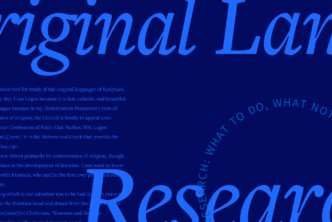One of the most intriguing topics in the Bible is related to the identification of the leviathan, a creature that has been identified with different characters (crocodile, sea monster, Satan). In this study, I will briefly analyze Isaiah 27:1 in its context. I will examine some keywords and compare them with Revelation 12:3 and 13:14. The previous analysis is important to understand how John uses the leviathan in his book.
The context of Isaiah 27:1 and its similarities to Revelation
Isaiah 27:1 seems to be the conclusion of chapter 26, which describes God’s judgment on the nations and the deliverance of his people. Isaiah 26:17–18 says, “As a pregnant woman about to give birth writhes and cries out in her pain, so were we in your presence, Lord. We were with child, we writhed in labor, but we gave birth to wind. We have not brought salvation to the earth, and the people of the world have not come to life.” These verses use the image of a woman giving birth to represent Israel’s condition. Despite the pain of childbirth, the mother is comforted by her newborn child. Nevertheless, the text describes that Israel’s pain and suffering at the hands of its enemies were in vain, for they “gave birth to wind.” In this regard, Gary V. Smith comments, “no new era of peace was inaugurated (no child was born) because they were still suffering from the Assyrian attack. This was a lamentable situation where God allowed the wicked to discipline his people.”
However, God would not leave his people without hope. Isaiah 27:1 is God’s answer to Israel’s lamentations, employing the symbol of the leviathan to illustrate the defeat of his enemies. In The Bible among the Myths, John Oswalt summarizes the conflict between God and the forces of evil as follows: “evil and destruction now seem to threaten the principles of justice upon which His order is founded, they will not prevail. God will triumph and those who have kept faith with Him will triumph with Him.” Namely, God would defeat the enemies of his people, something Israel could not do by its means.
To summarize, Isaiah uses two symbols (woman and leviathan). On the one hand, the woman in labor describes the pain and defeat of the Israelites by their enemies. On the other hand, the leviathan’s destruction provides hope to the Israelites and focuses on God’s power to deliver his people. In the following sections, I will concentrate on the study of key terms, such as “leviathan,” “serpent,” and “dragon.” I will also look at some verbal and thematic parallels between Isaiah 27:1 and Revelation 12 and 13.
Some keywords
The word liwyāṯān (“leviathan”) appears six times in the Bible, always in the Old Testament. This term occurs four times in the poetic books (Job 3:8, 41:1; Pss 74:14, 104:26) and twice in Isaiah (Isa 27:1; 51:9). Isaiah also uses the expressions “serpent” and “dragon,” which is a creature that lives in the sea. John employs the synonymous terms “serpent” and “dragon,” along with other words in Revelation 12:9. The Old Testament uses the term nāḥāš, commonly translated as “asp,” “snake,” “viper,” and “serpent”—Genesis 3:1 uses the same word as a reference to the serpent that deceived Eve in Eden.
The term ṯannin (“dragon”) refers to a sea or land monster. In the Old Testament, the dragon is associated with the sea or rivers (Neh 2:13; Ps 91:13; Isa 27:1, 51:9; Jer 51:34; Ezek 29:3, 32:2). Out of the seven times that the word “dragon” occurs in the Old Testament (Ps 91:13; Isa 27:1, 51:9; Jer 51:34; Ezek 29:3, 32:2), six times it is a power opposed to God, sometimes represented by Egypt or Babylon.
Verbal parallels
In Mesopotamian mythology, the leviathan was a seven-headed serpent that fought against the gods and the forces of good. Therefore, this creature was considered the personification of evil. The leviathan is similar to the sea beast (Rev 13) and the dragon (Rev 12), both with seven heads. The term “dragon” in the New Testament appears only in Revelation and is related to Satan (Rev 12:3, 4, 7, 9, 13, 16, 17; 13:2, 4, 11; 16:13; 20:2). The Septuagint (LXX) uses machaira (“sword”) in Isaiah 27:1, identifying the instrument used by God to kill the leviathan. John also uses machaira to describe that the sea beast “was wounded by the sword” (Rev 13:14). The following table summarizes these ideas.
| Isaiah 27:1 | Revelation 13:1–3, 14 | |
| Creature | Leviathan, Serpent, Dragon | Sea Beast |
| Habitat | Sea | Sea (v. 1) |
| Lethal Element | Sword | Sword (v. 14) |
The table above shows that Isaiah and Revelation display similarities regarding the creature (leviathan/sea beast), habitat (sea), and lethal element (sword). Furthermore, considering the analysis of the keywords, Revelation employs the same terms that the LXX uses for dragon and sword. Although the term thalassa (“sea”) does not appear in the LXX of Isaiah, the dragon is an aquatic animal, as I have mentioned elsewhere (Rev 12:15–16; cf. Ezek 32:2).

Thematic parallels
We have studied that Isaiah 27:1 is the conclusion of chapter 26. This chapter describes an Israel that could not defeat its enemies by its own strength, using the image of the woman in labor (v. 18). For this reason, Isaiah 27:1 uses the symbol of the leviathan, which represents Israel’s enemies. God defeats this creature by employing his sword. In other words, the source of salvation is God and not Israel.
John uses the image of the woman of Isaiah 26 in Revelation 12:5. Although Revelation describes a woman giving birth, in contrast to the description in Isaiah 26:18, John emphasizes that the woman still needs God’s protection (Rev 12:6). Therefore, like Isaiah, Revelation underlines that salvation comes from God.
The leviathan has similarities with the sea beast (Rev 13) and with the dragon (Rev 12). The connection between these creatures is not a surprise since both passages (12:17, 13:14) rely on Isaiah 27:1, and both characters (dragon and sea beast) are closely associated with each other. Moreover, if we consider the structure of Revelation 12, we will notice interesting connections with both passages (Isa 27:1; Rev 13). As we will see in the following contrast chiasmus.
- (A) The dragon attacks the woman’s son (vv. 1, 2).
- (B) God protects the woman (vv. 3, 4).
- (C) Battle in the heaven, which extends to the earth (vv. 7, 9).
- (D) Rejoicing because the blood of the Lamb provides victory (vv. 10, 11).
- (C’) Victory in heaven, no victory yet on earth (v. 12).
- (B’) The dragon attacks the woman (vv. 13, 15).
- (A’) God protects the woman (vv. 14, 16).
The center of the chiasmus emphasizes the joy of God’s people due to their deliverance, and it highlights that redemption comes from the blood of the Lamb. Verses 10–11 describe that joy takes place in heaven because of Satan’s expulsion (vv. 7–9). However, verse 12 relates that the earth and the sea could not yet experience that joy since the enemy had descended upon them with great wrath. Even though the battle between Michael and the dragon is important, John wants to emphasize that the main point is the joy of God’s people due to Jesus’s death (Rev 12:7–9). In other words, Isaiah 27:1 and Revelation 12 and 13 underline God’s victory over the leviathan/dragon/sea beast. Lastly, this means that Isaiah and Revelation describe that God is the one who conquers the enemies of his people. Therefore, God is the source of salvation.
Conclusion
We notice a close relationship between Isaiah 27:1 and Revelation 12:3 and 13:14 by comparing the terms “leviathan/dragon.” This relationship is supported by the verbal and thematic parallels between these texts. The context of Isaiah 27:1 (cf. Isa 26:18) employs the image of the woman in labor to describe the condition of Israel. The woman’s unsuccessful childbirth exemplifies Israel’s futile efforts to achieve salvation. However, God gives hope to his people by defeating the leviathan—a mythological creature that represents the enemies of God’s people.
John takes from Isaiah the image of the woman and the leviathan. Unlike the woman in Isaiah, the woman in Revelation gives birth to a male child. Despite this difference, John mentions that God protects the woman from the attack of the dragon/leviathan, just as God protected the woman in Isaiah. Therefore, as in Isaiah, John wants to emphasize that salvation comes from God.
The leviathan symbolizes the chaos and the destruction that opposes God’s people. This mythological creature bears similarities with the dragon and the sea beast of Revelation. The resemblances between these animals are strengthened by looking at the verbal and thematic parallels between them. The leviathan, the dragon, and the sea beast live in the sea, and God uses his sword to defeat them. Finally, the contrast chiasmus in Revelation 12 highlights that John used Isaiah 27:1 to emphasize the joy of God’s people in recognizing that salvation comes from God alone.
***
The author would like to thank the ORION program for its contribution to the funding of Maicol A. Cortés research internship. This work has benefited from a French government grant managed by the Agence Nationale de la Recherche with the reference ANR-20-SFRI-0009.
Related resources
The Trinity in the Book of Revelation: Seeing Father, Son, and Holy Spirit in John’s Apocalypse (Studies in Christian Doctrine and Scripture | SCDS)
Regular price: $17.99
The Bible among the Myths: Unique Revelation or Just Ancient Literature?
Regular price: $15.99







